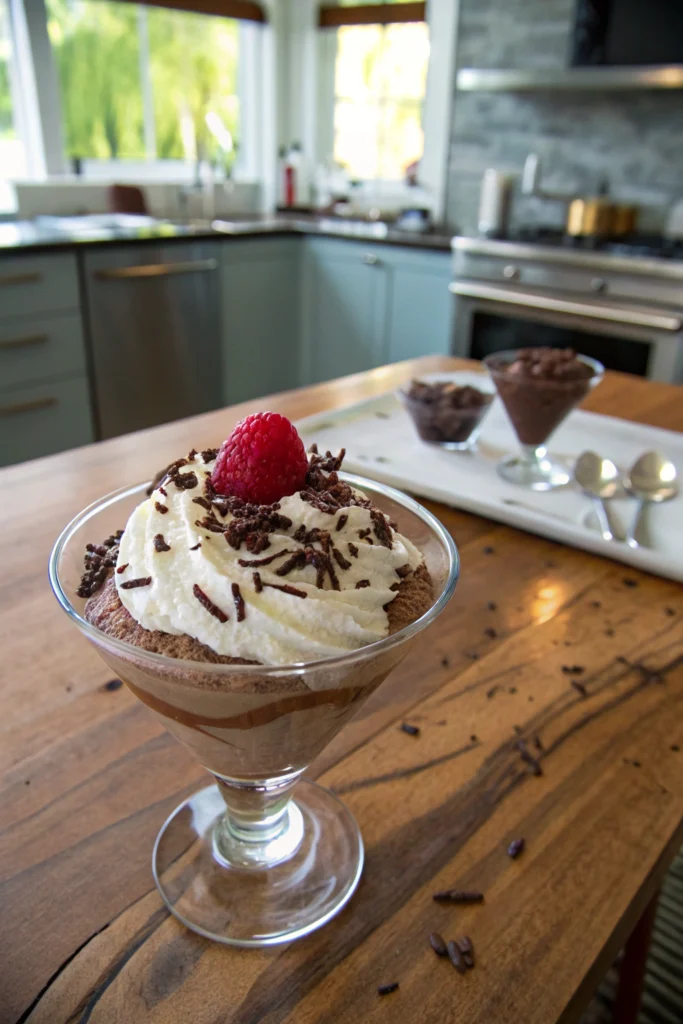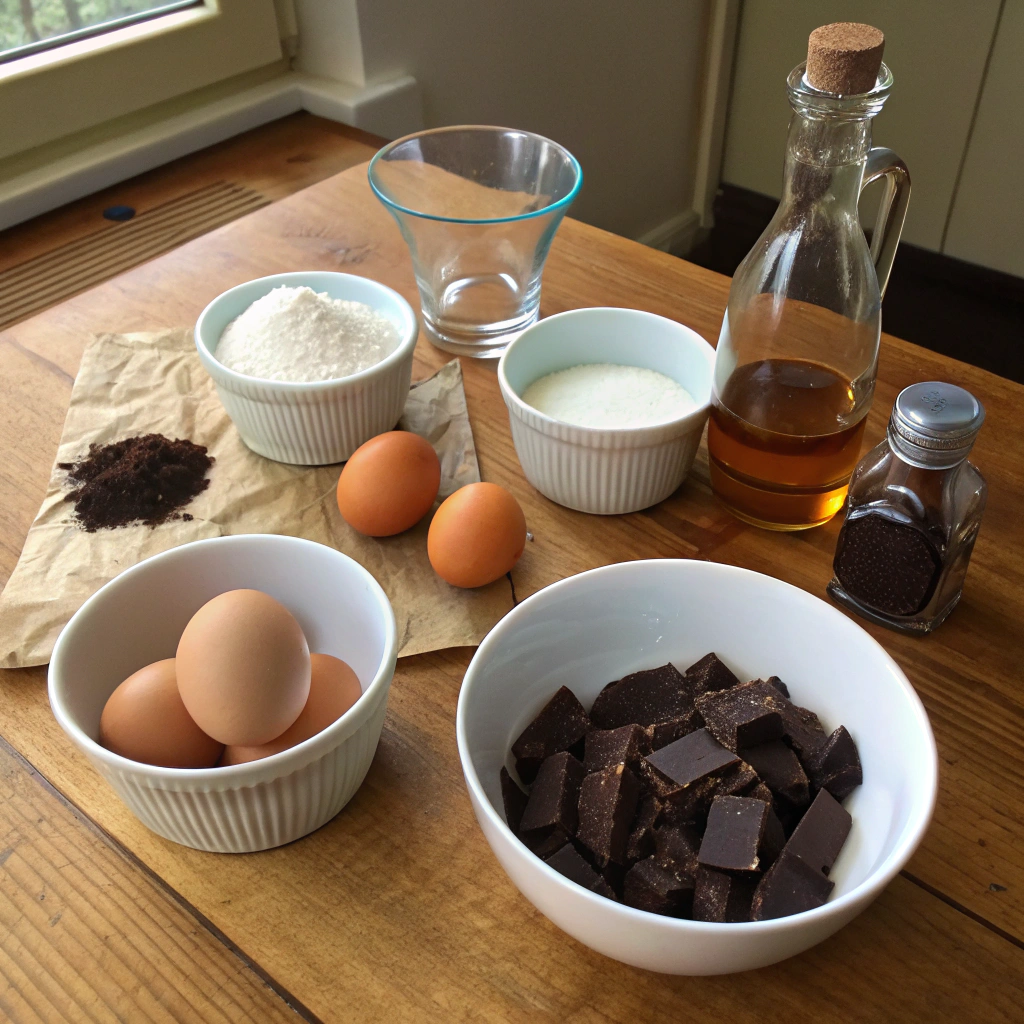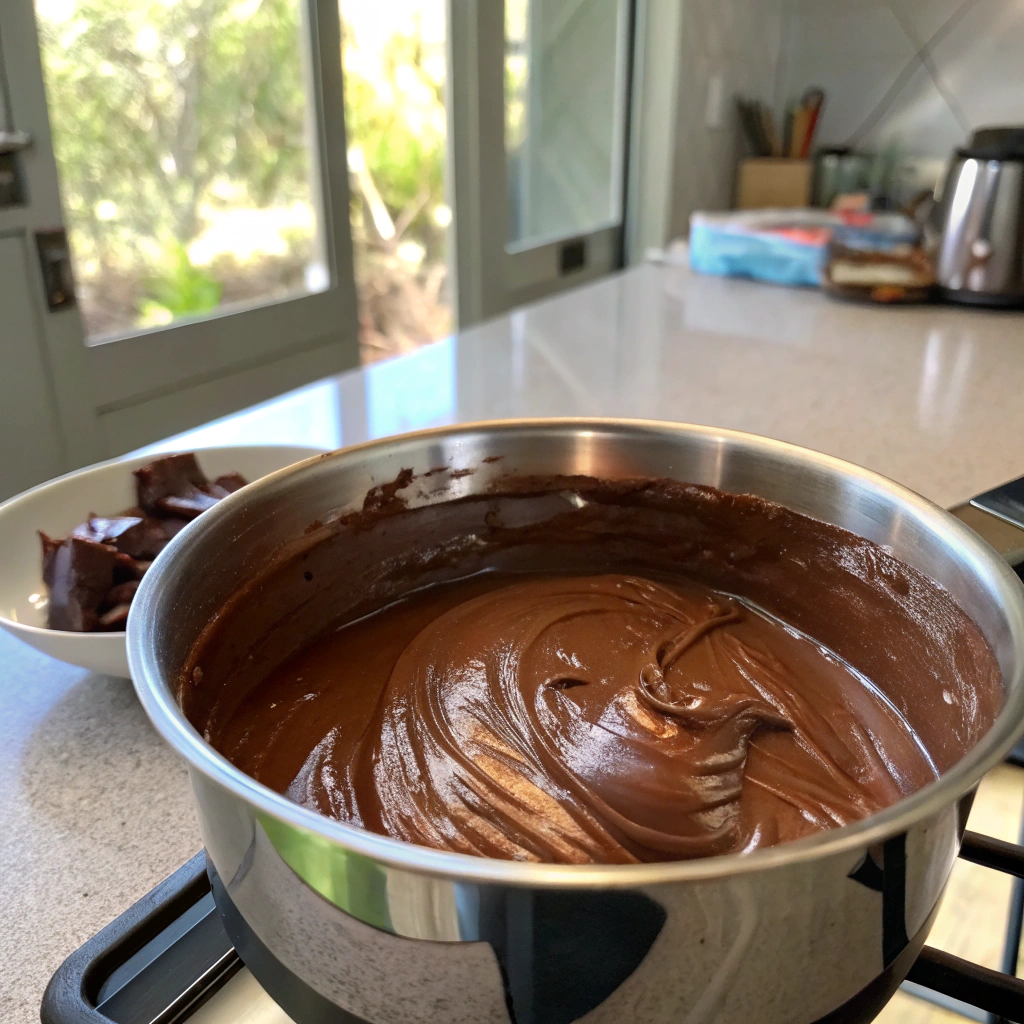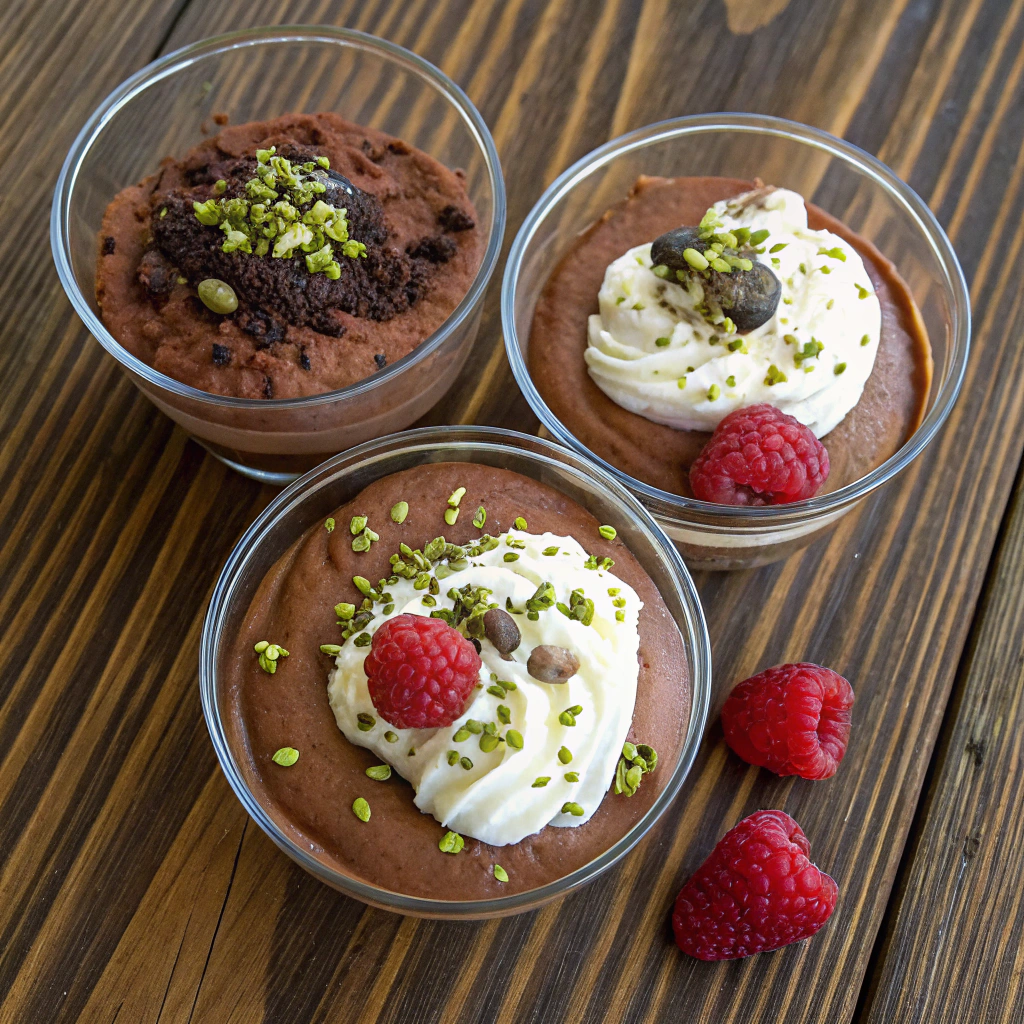Nutritional values
Servings: 6 ServingCalories:320kcalTotal Fat:24gSodium:75mgTotal Carbohydrate:22gDietary Fiber: 2gSugars: 18gProtein:6g

Oh my goodness, let me tell you about my journey with chocolate mousse! After countless attempts (and more than a few chocolate-covered disasters), I've finally mastered this dreamy dessert. Making the perfect chocolate mousse used to terrify me - all that talk about proper temperatures and folding techniques had me running for the store-bought pudding aisle! But here's the thing: once you understand a few key tricks, whipping up a silky-smooth chocolate mousse becomes totally doable. Trust me, if I can nail this recipe after dropping an entire bowl of melted chocolate on my kitchen floor (true story!), you've got this in the bag. Let's break down everything you need to know about creating this classic French dessert.
Y'all, temperature is seriously make-or-break when crafting chocolate mousse. Last Christmas, I learned this the hard way when my chocolate seized up into sad little chunks! Here's the deal: your melted chocolate needs to hit that sweet spot of 110-115°F before you start folding. Too hot, and your chocolate mousse will deflate faster than a soufflé in an earthquake. Too cool, and you'll end up with chocolate bits throughout your dessert (which, honestly, isn't the worst thing ever, but we're aiming for silky smooth here!). I keep an instant-read thermometer handy and always let my egg whites come to room temperature - about 30 minutes on the counter does the trick.
Listen up, because this is where the magic happens in chocolate mousse! Remember my first attempt when I stirred everything together like I was mixing cake batter? Yeah... don't do that. The secret to that cloud-like texture is all about gentle folding and proper whipping. Start with super-clean beaters (any trace of grease will ruin your egg whites) and whip those whites until they form soft peaks - think fluffy clouds, not stiff mountains. When you're folding in your chocolate mixture, use that figure-eight motion like you're conducting a tiny kitchen orchestra. I usually count to 45 while folding, which keeps me from over-mixing.
Here's something that took me way too many batches of chocolate mousse to figure out - not all chocolate is created equal! After testing everything from milk chocolate to those fancy 85% dark bars, I've found that 60-70% cacao hits the sweet spot. Anything higher makes your mousse taste bitter (learned that when I used my husband's fancy 90% dark chocolate - oops!), while milk chocolate can make it too sweet and soft. I usually grab Ghirardelli or Lindt bars from the baking aisle. Pro tip: never use chocolate chips - they've got stabilizers that'll mess with your chocolate mousse texture. Spring for the good stuff here, folks!

Creating the perfect chocolate mousse starts with choosing the right chocolate. High-quality dark chocolate with 70% cocoa content gives your mousse that rich, sophisticated flavor that makes French desserts so memorable. While some prefer making chocolate mousse with milk chocolate, I've found dark chocolate creates better texture and depth. Through years of testing, I've learned that chocolate bars work better than chips since they melt more smoothly and evenly. My favorite trick is combining two different dark chocolate varieties - one fruity and one nutty - to create complex flavors in the final mousse.
The success of your chocolate mousse depends heavily on using the freshest eggs possible. When making chocolate mousse at home, I always do the float test - fresh eggs sink in water while older ones float. Room temperature eggs create the fluffiest mousse because they whip up to maximum volume. Separating eggs is crucial since chocolate mousse requires only the yolks for richness and whites for structure. I learned the hard way that even a tiny bit of yolk in your whites can prevent proper whipping. Keep those whites pristine for the airiest chocolate mousse possible!
Heavy whipping cream is essential for achieving that signature silky texture in chocolate mousse. Always choose cream with at least 36% fat content - the higher fat percentage creates more stable whipped peaks. For the smoothest chocolate mousse, make sure your cream is very cold before whipping. I keep my mixing bowl and whisk in the freezer for 15 minutes beforehand. This simple step helps the cream whip faster and hold its shape better. Fresh cream tastes noticeably better than ultra-pasteurized varieties, though both will work in your mousse recipe.

Making chocolate mousse starts with perfectly melted chocolate. For perfect results, learning how to melt chocolate properly is essential for your mousse. I prefer using a double boiler method - place chopped chocolate in a heatproof bowl over simmering water, making sure the bottom doesn't touch the water. Stir gently and remove from heat just before it's completely melted. The residual heat will finish the job without risking scorched chocolate. When making chocolate mousse, temperature control is crucial. Let the melted chocolate cool slightly before folding in other ingredients. Too hot, and it'll deflate your carefully whipped cream and eggs.
The key to light, airy chocolate mousse lies in proper folding technique. Start by gently incorporating a small portion of whipped cream into your chocolate base to lighten it. Then add the remaining cream in three parts, using a large spatula to cut through the middle and fold the mixture over itself. When making traditional chocolate mousse, fold in the egg whites last - they're the most delicate. Watch for any white streaks, which mean you need to fold a few more times. The final texture should be uniform but still fluffy.
The final steps of preparing chocolate mousse require patience and attention to detail. Once all ingredients are folded together, spoon the mixture into serving glasses carefully to maintain those precious air bubbles. Tap each glass gently on the counter to remove large air pockets that could create an uneven texture in your chocolate mousse. Chill for at least 4 hours, though overnight is better. I've discovered that covering each glass with plastic wrap prevents that unwanted skin from forming on top of the mousse.
Getting your chocolate mousse to set properly can be tricky, but understanding the science helps. Temperature plays a crucial role - if your melted chocolate is too hot when folding in the whipped cream, it'll deflate those precious air bubbles. I learned this the hard way when making chocolate mousse for my sister's birthday! The ideal temperature for folding is around 110°F.
Another common issue is underwhipping your cream. For the perfect mousse texture, whip to firm peaks that hold their shape but aren't buttery. Chilling time matters too - give your mousse at least 4 hours in the fridge, though overnight is even better. If you're still having trouble, check your cream's fat content - you'll want heavy cream with at least 36% fat.
Making silky chocolate mousse starts with properly melted chocolate. Seizure happens when even tiny drops of water touch your melting chocolate, turning it into a grainy mess. I always keep my bowls and utensils bone-dry when working with chocolate. Using a double boiler method helps prevent overheating, which can also cause seizure. Keep the water at a gentle simmer, not a rolling boil. If your chocolate mousse recipe calls for liqueurs or other liquid flavors, warm them slightly before adding to prevent shock. Another tip I've learned is to melt chocolate with a little butter - it helps create a smoother texture and reduces the risk of seizing.
Nobody wants a grainy chocolate mousse, but don't worry - there are ways to save it! If your mousse turns grainy, it's usually because the chocolate wasn't properly tempered or moisture snuck in. To rescue grainy chocolate mousse, try gently rewarming it over a double boiler while whisking constantly. Once smooth, let it cool to room temperature before folding in freshly whipped cream. Sometimes adding a tablespoon of warm heavy cream can help smooth things out. I've saved many batches this way! If all else fails, embrace the texture and call it "rustic" - sometimes kitchen mistakes lead to happy accidents. Just remember to strain any lumps before the final fold.

Creating a dairy-free chocolate mousse doesn't mean sacrificing that classic silky texture. Coconut cream makes an excellent base - just chill the can overnight and whip the solid cream portion. I've made this version of chocolate mousse for vegan friends and they couldn't believe it was dairy-free! Avocado is another fantastic option, providing healthy fats and a creamy texture. When using avocado, make sure it's perfectly ripe and blend thoroughly to avoid any green bits. The key is using high-quality dark chocolate that's naturally dairy-free. You can also experiment with cashew cream - just soak raw cashews overnight and blend until super smooth.
Making chocolate mousse without eggs is simpler than you might think! The secret lies in getting the right balance of chocolate and whipped cream. Start with high-quality chocolate - it really makes a difference in the final texture of your mousse. I've found that a 70% dark chocolate works beautifully. Melt the chocolate gently, then let it cool until just warm to touch. Meanwhile, whip your cream to firm peaks. The folding technique is crucial here - be gentle but thorough to maintain those air bubbles. This eggless chocolate mousse version is perfect for pregnant friends or anyone with egg allergies.
Taking your chocolate mousse to the next level is all about creative flavor combinations. Try infusing the cream with fresh mint leaves before whipping - it adds such a lovely freshness to the chocolate mousse. Orange zest and a splash of Grand Marnier create a sophisticated twist on classic chocolate-orange. During fall, I love adding a pinch of cinnamon and nutmeg. For coffee lovers, dissolving instant espresso powder in the melted chocolate works wonders. You can also layer your mousse with crushed cookies, toasted nuts, or fresh berries. My personal favorite is adding a hint of sea salt and candied ginger - the sweet-salty combo is irresistible!
Ready to create your own perfect chocolate mousse? I'd love to see your results! Share photos of your creations in the comments below or tag us on social media. Join our growing community of home bakers and get exclusive tips, seasonal variations, and troubleshooting advice. If you enjoy this recipe, you might also love our german chocolate cake recipe for another decadent chocolate dessert. Sign up for our weekly newsletter to receive fresh recipe ideas and chocolate-making secrets straight to your inbox.
This rich and airy chocolate mousse combines high-quality dark chocolate with perfectly whipped cream and egg whites for a luxurious French dessert. The result is an impossibly smooth, cloud-like texture that's both decadent and light. Perfect for special occasions or whenever you crave something truly spectacular.
Stir egg yolks into cooled chocolate until well blended
Divide mixture among 6 serving glasses
Servings: 6 ServingCalories:320kcalTotal Fat:24gSodium:75mgTotal Carbohydrate:22gDietary Fiber: 2gSugars: 18gProtein:6g
Storage:
Keep refrigerated for up to 3 days, covered with plastic wrap.
Substitutions:
For dairy-free: Use coconut cream instead of heavy cream
For egg-free: Double the whipped cream amount and omit eggs
For different flavors: Add 1 teaspoon espresso powder or orange zest
Serving Suggestion:
Top with fresh whipped cream and chocolate shavings. Serve chilled with fresh berries on the side.